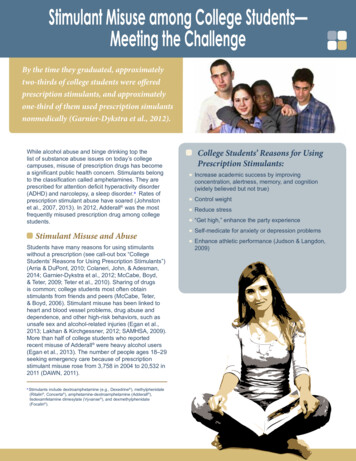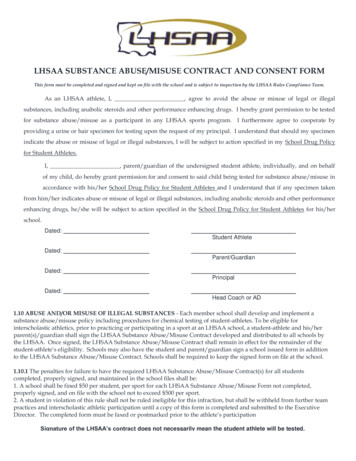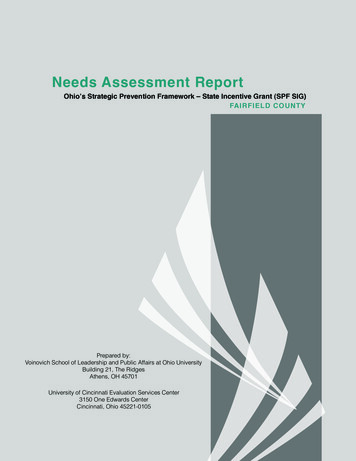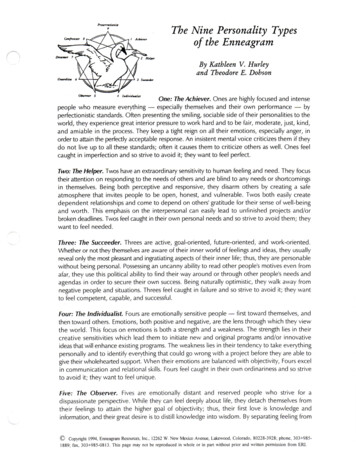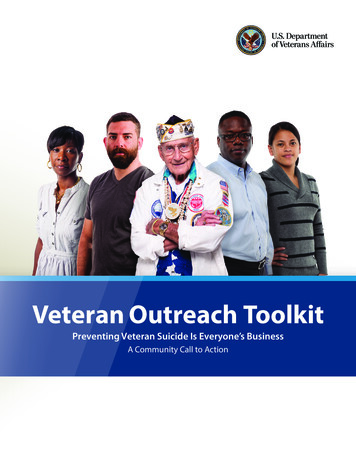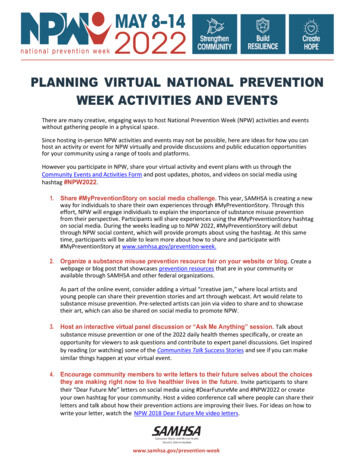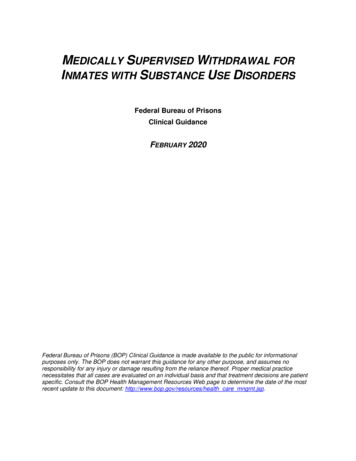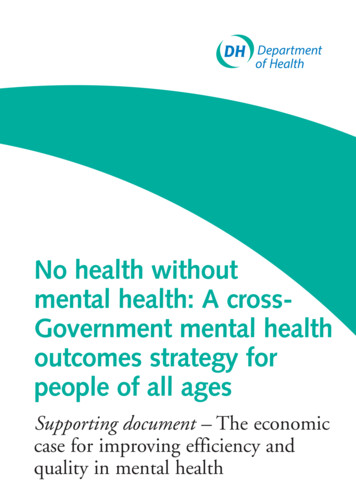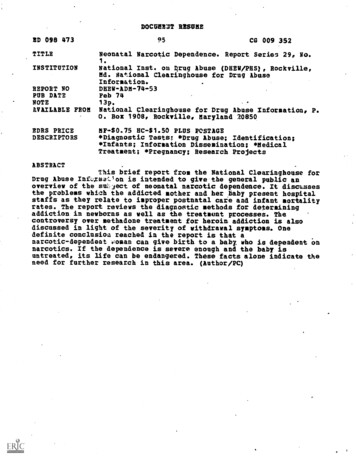
Transcription
DOCUOUT MISUSEED 098 473TITLE95CG 009 352Neonatal Narcotic Dependence. Report Series 29, No.1.INSTITUTIONREPORT NOPUB DATENOTEAVAILABLE FROMEDRS PRICEDESCRIPTORSNational Inst. ou Ilrug Abuse (DHEN/PHS), Rockville,Md. National Clearinghouse for Drug AbuseInformation.DBEW-ADN-74-53Feb 7413p.National Clearinghouse for Drug Abuse Information, P.O. Box 1908, Rockville, Maryland 20850IMF - 0.75 BC- 1.50 PLUS POSTAGE*Diagnostic Tests; *Drug Abuse; Identification;*Infants; Information Dissemination; *MedicalTreatment; *Pregnancy; Research ProjectsABSTRACTThis brief report from the National Clearinghouse forDrug Abuse Inf,xme.'on is intended to give the general public anoverview of the sul,ject of neonatal narcotic dependence. It discussesthe problems which the addicted mother and her baby present hospitalstaffs as they relate to improper postnatal care and infant mortalityrates. The report reviews the diagnostic methods for determiningaddiction in newborns as well as the treatment processes. Thecontroversy over methadone treatment for heroin addiction is alsodiscussed in light of the severity of withdrawal symptoms. Onedefinite conclusion reached in the report is that anarcotic-dependent .roman can give birth to a baby who is dependent annarcotics. If the dependence is severe enough and the baby isuntreated, its life can be endangered. These facts alone indicate theneed for further research in this area. (Author/PC)
BEST COPY AVAILABLEIISERIES 29, NO. 1U.S. DEPARTMENT OP HEALTH,EDUCATION *WELFARENATIONAL INSTITUTE OFEDUCATIONTsitS DOCUMENT HAS SEEN REPRODuCED EXACTLY AS ft ECEWED FROMFEBRUARY 1974THE PERSON OR CIROANtZATION ORIGINATING IT POINTS OP WEW OR bPiNtONSSTATED DO NOT NECESSARILY REPRESENT OFFICIAL NATIONAL INSTITUTE OFEDUCATION POSITION OR PCIL:CYpr. 1r%.The National Clearinghouse for Drug Abuse Information recognizes the needfor clarifying some of the more complex issue, in drug abuse by gatheringthe significant research findings on each subject and developing fact sheetson the problem. These fact sheets, which are part of the ClearinghouseReport'Series . present information about treatment modalities, the pharmacology and chemistry of various drugs of abuse, and opinions and practicesof recognized authoriti es in the field. This publication was prepared by theClearinghouse and Donald R. Wesson Associates, 527 Irving Street, SanFrancisco, California 94122, under Contract No. }ISM 42-72-99.44.COCT'c)atw1INEONATAL NARCOTIC DEPENDENCEInfants born to narcotic-dependent mothers are often themselves physically dependent on heroin. When deprived of the narcotics it has received through the mother'splacenta, the newborn child may develop withdrawal symptoms. Although the newlyborn infant is often referred to as the "easiest addict to cure" because of the absenceof a psychological dependence, failure to make an early diagnosis and begin treatment can endanger the life of the infant.riBoth the addicted mother and her baby present hospital staff with numerous problemswhich inhibit the opportunity for proper postnatal care. The mother usually waitsuntil the last possible moment to enter the hospital and often tales narcotics justprior to admission to relieve labor pains. In spite of the fact that medical complications in both mother and child occur at a high rate, it is difficult to convince theaddict to remain in the hospital once her child is delivered. The mother often beginsto feel the effects of withdrawal herself and will leave the hospital to obtain moreheroin. In addition, the mother's fear that her addiction will be detected will causeher to leave the hospital against medical advice, taking her narcotic-dependent babywith her.
EpidemiologyBESTCOAV IMLABLEhas neverThe magnitude of the problem of narcotic dependence in newborn infabeen determined with any degree of accuracy. Although it is known that 80 to 85is impossiblepercent of addicted women are in the childbearing ages of 14 tonumber ofto determine the number of births in this group without knowing the taddicts and the percentage of these that are women. Furthermore, the birthrateamong this group is usually based on cases of women who come to a hospital or clinicfor delivery. An unknown number of pregnant addicts self-deliver or deliver at homewithout a physician in attendance. The problem of obtaining statistics is further coinpeunded because some hospitals do not report these cases.Stone (1971), in the American Journal of Obstetrics and Gynecology, reported on his10-year observation of pregnant addicts at .'w York's Metropolitan Hospital. He estimated that in 1960 there was one birth to a drug-addicted mother for every 164 deliveries and that in 1969 the ratio had increased to one in 47. Zimmerman (1972) presented similar figures and stated that in 1971 the total number of reported cases ofneonatal narcotic addiction in New York City was 550. This total rose to more than800 the following year.Not all babies born to narcotic-dependent mothers exhibit withdrawal symptoms. Estimates of the percentage of children born to narcotic-dependent mothers who exhibitwithdrawal syMptoms range from 50 percent to 90 percent. Sussman (1963) studied19 addicted mothers and their babies and found that 17 of the babies had withdrawalsymptoms. Perlmutter (1967) studied 21 babies of addicted mothers and found that54.5 percent exhibited withdrawal symptoms. A French study reported in ConcoursMedical (1972) that of 384 babies born to addicted mothers, 259 had withdrawals y mp toms .The mortality rate for addicted babies is another area in which little is known. Thesame factors which make estimating the number of births difficult make ascertainingdeath rates for this population difficult. To complicate the problem. pregnant addictswho enter the hospital to have their babies often leave within 1 or 2 days. Sincewithdrawal symptoms'may npt appear until a day or so later , it cannot be knownwhether their babies are addicted or w'lat will happen to them if they are.Estimates of mortality rates for untreated narcotic-dependent babies run as high as96 percent. Deaths among narcotic-dependent babies are often attributed to dehydration from diarrhea, lack of food intake, multiple congenital anomalies, pneumonia,incomplete expansion of lungs at birth or intracranial hemorrhage.DiaknosieThe diagnostic procedure for determining narcotic-dependence in newborn babiesusually begins with a maternal history. However, many addicted women are hesitant
to admit their use of narcotics, others exaggerate the extent of their habit.in the hopeof obtaining more drugs, and some will mislead the physician by admitting to theiruse of only one drug when, in fact, they are using several drugs. Hence, this procedure often proves unreFiable in determining whether the child is narcotic-dependent.If maternal narcotic dependence is suspected, a chromatographic analysis of theinfant's urine assists in The diagnosis. It is possible for narcotics given to the motherduring labor to show up in the :nfantrs urine, .since lieroin is metabolized to morphine.Moreover, the presence of quinine, which is frequently used to cut heroin, would suggest illegal drug use. Demerol the most commonly used drug for obstetric analgesia,can be detected and is distinguishable from morphine.The symptoms of drug withdrawal in the newborn are similar to other complicationswhich are not related to drug abuse and, hence, diagnosis is difficult. Meningitis,hypoglycemia, central nervous system infection, and respiratory difficulties all present symptoms which can be mistaken for narcotic withdrawal symptoms. Althoughthere are no specific symptoms unique to narcotic withdrawal, some symptoms whichmay indicate withdrawal n newborn babies are:Highly SuggestiveSuggestiveL -itabilityTremorsSneezingVomitingTwitchingBlueness of skin due to insufficientoxygenation of the bloodYawningHigh-pitched cryHyperactivityPoor food intakeDiarrheaFeverSustained embracing reflexSeizuresRespiratory distressApnea (transient cessation of breathing)Nasal stuffinessTearingExcessive sweatingThese signs usually occur within the first 4 days after birth. The most likely toappear first' are irritability, high-pitched shrill cries and tremors. It is importantto remember that these symptoms are not necessarily indicative of narcotic withdrawal, although their appearance should warrant further examination, particularlyif they appear ip combination.The most common medical complication for the infant is low birth weight for its gestational age. More than one-half of narcotic-dependent babies weigh less than 5.51pounds at birth (average normal weight is 7.04 pounds). Prematurity also occursmore often with this population along with a high incidence of low fetal tissue oxygenlevels and aspiration of meconium. Some investigators have reported an increasedincidence of inguinal hernias, perhaps related to the infant's hyperactive behavioror hyperirritability.
AVAILABLEBEST COPYMedical complications in the mother observed with increased frequency are anemia,syphilis, infectious hepatitis, malnutrition and diabetes. Such difficulties are relatedmore directly to the life style of the mother than to the use of her.sin.Obstetric pi oblonts which occur more frequently with narcotic-dependent mothersare premature labor, breech presentations of the fetus, premature rupture of themembranes and toxemia. Many of these complications can be attributed to the resultof inadequate prenatal care. it is often difficult for a pregnant narcotic addict toobtain medical attention because of a lack of funds or because of fear of divulging herillegal drug use.FtiOlogyIt is the mother's use 61 narcotics that causes the newborn baby's physical dependence on narcotics: the father's physical dependence cannot be transmitted to thefetus. The fetus is exposed to narcotics by passage of the drugs through the mother'splacenta. The amount of drug that does reach the fetus is minute, even if the mothertales large doses: thus, detection of narcotics in the placenta. amniotic fluid, fetalblood or fetal tissues is difficult.The effects of narcotics on the fetus are the subject of much speculation. The drugsentering. the circulatory system of the fetus, depending on the amount and frequencywill produce in the newborn child the same physical changes present in the mother.The reason that some children of addicted mothers are not born narcotic- dependentmay relate to individual ability to metabolize drugs or to the drugs not crossingthe placenta or crossing it in insufficient amounts. The infant may also be insensitive and will not respond to the drug unless a metabolic change occurs to triggerthe onset of withdrawal signs.Carl Zelson (1971) of the Pediatric Department of the New York Medical College,Metropolitan Hospital Medical Center, has drawn several conclusions based uponhis 10 years of observing maternal addiction:I.The larger the maternal intake of heroin, the more frequentis the incidence of withdrawal in her baby.2.There is a direct correlation between the time of the lastdosage of heroin by the mother before birth and the likelihood of the newborn infant's manifesting withdrawal signs.3.The longer the maternal addiction, the more frequent is theoccurrence of withdrawal in the newborn child.Several reports in the literature have offered the hypothesis that opiates possiblyinterfere with fetal nutrition by an effect upon the placenta, thus accounting for the4
AVAliABLEBES1 COOaEST COPY AvAnlatihigh incidence of low birth weight among narcotic-dependent babies, 'However,narcotic addiction is not the only possible explanation for the lack of normal development observed in this group of infants. The life style often associated with addietion frequently plays a role in contributing to the health problems of the newbornbaby. Maternal malnutrition, tobacco smoking, lack of or poor prenatal care, unhealthy sanitary conditions , and multiple drug use by the mother can also contributeto the child's underdevelopment.ResearchMost conclusions regarding the 'causes and effects of neonatal narcotic dependencehave been based solely on clinical observations. This accounts for the markedlYdiffering views on several aspects of withdrawalincluding the nature and durationof symptoms , results of treatment, and mortality rate.Zelson (1971) clinically observed 3R4 babies born to addicted mothers in a 10-yearperiod at Metropolitan Hospital in New York City. Of the children he studied,nearly one-half were of low birth weight (under 5.51 pounds), two-thirds exhibitedwithdrawal symptoms in the first 4 days of life and two-thirds of this latter grouprequired treatment. 'e:elson used chlorpromazine (ThoazineR) to relieve the with-drawal signs.Studies by Glass and Evans (1972) and Zimmerman (1972) support Zelson's findingsthat about half of the infants born to addicted mouiers weigh less than 5.51 pounds.Few laboratory studies have been conducted to study the mechanisms of infant dependence. The problems inherent in generalizing from laboratory studies of addictionare that strict laboratory controls regarding dosage level, frequency of dosage, andenvironment can be maintained: human abuse, however, is uncontrollable, ofteninvolving contaminated drugs, varying dose levels at varying frequencies, andmultiple drug use. In addition, the same drug may cause different pharmacologicalreactions in different animal species, so that drugs causing genetic damage inanimals may or may not produce the same changes in humans.In a study to assess the role of maternal narcotic use upon offspring development,Friedler and'Cochin (1972) treated female rats with morphine sulfate for 5-1/2 to10 days prior to a 5-day withdrawal period and mated the rats immediately followingthe withdrawal period. Fven though not exposed to the drug either in utero or postnatally, the offspring exhibited retarded growth at 3 to 4 weeks of age. The experimenters state that the alterations in growth patterns of the offspring suggest aninfluence by morphine on the'eells or organ systems of the mother. They then conclude that morphine may exert a profound and long-lasting effect on P,nimals notdirectly exposed to the drug.Numerous other laboratory experiments have demonstrated that drugs may affectfetal development either by a direct chemical effect or by an alteration of the maternalenvironment during the gestational period.5
fPINlk.101.k.101About 50 percent of infants having withdray.al symptoms will need nothing more thanfrequent holding, swaddling and careful feeding to alleviate much of their discomfort,hyperirritability and hyperactivity. Under these circumstances, medication may notbe necessary. In cases of more severe manifestation of symptoms, medication may beused. In these cases , treatment of hospitalized infants can last from 10 to 40 days.Narcotics ,.barbiturates, phenothiazines or sedative-hypnotics have all been usedtreat withdrawal symptoms in newborn addicted babies. There is no single drugthat seems to have a clear advantage over the others, and each has limitations.toParegoric (camphorated tincture of opium) was the earliest therapeutic agent usedand was found to be effective in the relief of withdrawal symptoms. Morphine andmethadone have also been used to treat infant withdrawal. Treatment with morphineis extremely difficult to control and is recommended only for extreme cases whereother medications produce no response. Methadone has been used with success,although the fact that it prolongs the infant's hospitalization is a serious drawback(Krause et al. 1958)Many physicians currently feel, however, that a narcotic should not be given torelieve addiction. Zelson (1971) in his treatment of addicted infants has been reluctant to use a narcotic because he believes that the intrauterine exposure to heroinproduces a metabolic change which may be accentuated by the use of another narcotic agent.Phenobarbital and chlorpromazine have both proved effective in treating symptomsof narcotic withdrawal. In a study by Kahn et al. (1969) comparing the effectivenessof these two agents in controlling symptoms, no differences between them could befound. More recently, diazepam has been used with some success. A study byNathenson et al. (1971) showed that diazepam is effective with short treatment courses(2.9 3.6 days) and was free of major side effects. Persistence of diarrhea was theonly major disadvantage. Others feel, however , that diazepam has no clear advantag'.1s over phenobarbital.drawbacks of using barbiturates for relieving withdrawal are that they may notcontrol the gastrointestinal abnormalities, often encountered, and they may intensifyrespiratory distress. In using chlorpromazine, a too-rapid or sudden reduction ofdosage can cause a recurrence of all manifestations of withdrawal. Chlorpromazinemay also interfere with the detection of seizures in these infants.TheThere are similar questions concerning other forms of drug treatment. AlthoughGlass and Evans (1972) recommend the use of phenobarbital and chlorpromazine,Zimmerman does not recommend using phenobarbital, methadone or paregoric becauseof their addictive properties. Sussman (1963) warns that use of sedatives and narcoticsrequires caution, since breathing ability , already impaired by the addiction, maybe further depressed.6
01 COO WOKEIn summary , although various drugs have proven useful in treating narcotic withdrawal symptoms in newborn infants . many medical people feel it is best to avoiduse of drugs unless the symptoms become severe enough to be life-threatening, Itis also important to offer supportive therapy for complications and coexisting medicalproblems . Such therapy would include: (1) treatment of infection when present,(2) adequate fluid intake (intravenously if vomiting or diarrhea is present), and(3) treatment of concurrent metabolic aberrations.Another approach to treatment is to withdraw the mother and fetus during pregnancy.However, in view of the simple and effective treatment procedures for the narcoticdependent baby, this may not be recommended if there is a possibility of jeepi "zingthe pregnancy .Heroin Vs. MethadoneMuch controversy has arisen over whether children born to mothers taking highdoses of methadone are better or worse off than those born to women addicted toheroin. In more pi ecise terms, the issue involves such questions as whether withdrawal symptoms are exhibited by both heroin-dependent babies and methadonedependent babies whether heroin or methadone is more likely to cause addictionin the newborn infant, whether the symptoms are of a similar type and degree, andwhether one is more easily treated than the other. Studies thus far completed haveyielded contradictory results concerning these questions. It is apparent that nodefinitive statements can be made at this time concerning the question of which drugis more dangerous to the dependent infant. The conflicting vitws are evident fromthe studies cited below .Biathlon (1970) has reported on numerous cases of infants born while the motherwas taking methadone in comparison to a group of infants born to mothers who continued their use of heroin during pregnancy. The withdrawal symptoms exhibitedby the methadone group were approximately the same as heroin withdrawal symptomsbut a bit less pronounced. In those infants who required treatment, the same procedures were followed as for heroin-dependent babies:' however, the average periodof hospitalization of methadone babies was l5 days while the heroin-dependent infants'stay was 40 days.Glass and Evans (1972) also found milder withdrawal symptoms in methadone-addictedbabies as compared, to heroin-dependent infants. However , in their study , durationof treatment was longer for the methadone-addicted children.Other studies have reported opposite findings. Zimmerman (1972) reported thatmethadone-dependent babies have more severe withdrawal symptoms than heroindependent babies. Rajegowda et al. (1972) studied 38 babies born to heroin-addictedmothers and 15 born to mothers who were taking methadone. Results showed thatirritability and tremulousness occurred at a much higher rate for methadone babies7
BEST COPY AVAILABLE(13 out of 15) than for heroin babies (15 of 38). Furthermore, the symptoms persistedlonger in the methadone babies. Treatment with phenobarbital lasted 4 to 11 days forthe methadone babies compared to a treatment duration of 2 to 7 days for the heroinbabies.From these studies, it can be seen that the question of whether withdrawal frommethadone or withdrawal from heroin is more dangerous to the newborn infant isfar from being resolved and that until more evidence is accumulated, no conclusionscan be reached.Conclusion.From the above discussion, it is evident that many uncertainties still remain withregahl to neonatal narcotic dependence. Discussion continues concerning precisecauses and symptoms, the most efficacious treatment procedures, the relative severityof heroin dependence as compared with methadone dependence in the newborn, andnumerous other issues. Certain facts, however, are clear. A narcotic-dependentwoman can give birth to a baby who is dependent on narcotics: and, if the. dependenceis severe enough and the baby is untreated, its life can be endangered. These factsalone indicate the need for further research in this area.Not only must effective treatment procedures be established, .butpreventive effortsbased on reliable information are necessary . Prospective parEnts should be madeaware of the possible harm that could come to their offspring as a result of theirdrug-taking behavior.8
GOVIANtraiatiReferencesBlatman , Saul. Methadone and children. Pediatrics, 48(2)(Commentaries):173-175, August 1971.Blatrnan, Saul. Neonatal and follow-up. In: Proceedings of the Third NationalConference on Methadone. Washington, D.C.: Superintendent of Documents,U.S. Government Printing Office, 1970. pp. 82-85.Blinick,. George. Obstetrical aspects through the delivery room. In: Proceedingsof the Third National Conference on Methadone. Washington, D.C.:Superfntendent of Documents, U.S. Government Printing Office, 1970.pp. 80-82.Blinick, Ge,Jrge; TaVolga, William N.; and Antopol, William. Variations in birthcries of newborn infants from narcotic-addicted and normal mothers.American Journal of Obstetrics and Gynecology, 110(7):948.958, August 1,'1971.Blinick, George; Wallach, Robert C.; and Jerez, Eulogio. Pregnancy in narcoticsaddicts treated by medical withdrawal: the methadone detoxification program,American Journal of Obstetrics and Gynecology, .105(7): 997-1003, December 1,1969Cobrinik , Ralph W.; Hood, Thornton, Jr.; and Chusid, Emanuel. The effect ofmaternal narcotic addiction on the newborn infants: review of literature andreport of 22 Cases . Pediatrics, 24(2): 288-304, July-December 1959.Cohen, S.N. and Neumann, L.L. Methadone Maintenance During Pregnancy.American Journal of Diseases of Children, 126:445-46, 1973. .Concours Medical. Drug addiction in neonates. Concours Medical .(Paris), 94;8):1413-1414, February 19, 1972.Douglas, Gordon W. Discussion. American Journal of Obstetrics and Gynecology,109(5): 720-723, March I, 1971.Finnegan, L.P.; Connaughton, J.F.; Emich, J.P.; and Wieland, W.F. Compre-hensive care of the pregnant addict and its effect on maternal and infant outcome. Contemporary Drug Problems, 1(4): 795-809, Fall 1972.Friedler, Gladys, and Cochin, Joseph. Growth retardation in offspring of femalerats treated with morphine prior to conception. Science. 175(4022): 654-656,February 11, 1972.Glass, Leonard, and Evans, Hugh E. Narcotic withdrawal in the newborn.American Family Physician, 6(1):75 -78, July 1972.
BES1COrl NIMUVItiGoodfriend, Milton J.; Shey, , Irving Alfred; and Klein, Milton D. The effects ofmaternal narcotic addiction on the newborn. American Journal of Obstetricsand Gyncology , 71(1): 29--36, January 1956.Hill, Reba Michels, and Desmond, Murdina M. Management of the narcotic withdrawal syndrome in the neonate. Pediatric Clinics of North America, 10(1):67-86, February 1963.Iftgall, David, and Zuckerstatter, Marguerite. Diagnosis and treatment of the pas sively addicted newborn. Hospital Practice, 5(8):101-104, August 1970.Kahn, Eric J.; Neumann, Lois L.; and Polk, Gene-Ann. The course of the heroinwithdrawal syndrome.in newborn infants treated with phenobarbital orchlorpromazine. Journal of Pediatrics , 75(3): 495-500, September 1969.Krause, S.0.; Murray , P.M.; Holmes, J .B .; and Burch, R.E. Heroin addictiamong pregnant women and their newborn babies. American Journal ofObstetrics and G necoloa,. 75(4): 754-758, April l958.Medical Tribune. Clinic provides health care for pregnant heroin addicts. MedicalTribune, August 25, 1971. p. 20.Medical World News. Babies seem better off when the mothers are on methadone.Mecii.cal World News, 13(28):16-18, July 21, 1972.Medical World News. Managing the pregnant addict and her baby . Medical WorldNews, 12(19):20 -22, May 14, 1971.Nathenson, Gerald: C,Aden, Gerald S.; and Litt, Iris F. Diazepam in the management of the neonatal narcotic withdrawal syndrome. Pediatrics, 48(4): 523-527,October 1971.Perlmutter, Johanna F. Drug addiction in pregnant women. American Journal ofObstetrics and Gynecology , 99(4): 569-572, October 15, 1967.Rajegowdai 8.K.; Glass, Leonard; Evans, Hugh E.; Maso, Graciella, Swartz,Donald P.; Leblanc, Weiner. Methadone withdrawal in newborn infaxits.Journal of Pediatrics, 81(3): 532-534, September 1972.Schulman, Carol A. Alterations of the sleep cycle in heroin-addicted and "suspect"newborns. Neuropaediatrie, 1(1): 89-100, 1969.0.1.1Stone, M.L . ; Salerno, L.J.; Green, M.; and Zelson, C. Narcotic addiction inpregnancy. American Journal of Obstetrics and Gynecology , 109(5): 716. 723,March 1, 1971.
BEST COPY AVAILABLESussman, Sidney . Narcotic and methamphetamine use during pregnancy. AmericanJournal of Diseases of Children. 106:125-130, September 1963.Time. The youngest addicts. 'Time, January 22, 1973.Wesson, Donald R.; Gay , George R.; and Smith, David E. Treatment techniquesfor narcotic withdrawal with special reference to mixed narcotic-sedativeaddiction. Journal of Psychedelic Dru4(2):118-122, Winter, 1971.Wilson, G.S. et al. Early Development of Infants of Heroin-Addicted Mothers.American Journal of Diseases of Children, 126:457-62, 1973.Zelson, Carl; Rubio, Estrellita; and Wasserman, Edward. Neonatal narcotic addiction: 10 year observation. Pediatrics, 48(2):178-189, August 1971.Zimmerman, David. Neonatal addiction problem increasing. Journal (AddictionResearch Foundation) . 1(7):9. December 1. 1972.The National Clearinghouse for Drug Abuse Informatiori, operatedby the National Institute on Drug Abuse on behalf of the SpecialAction Office for Drug Abuse Prevention and the Federal agenciesengaged in drug abuse education programs , is the focal point forFederal information on drug abuse. The Clearinghouse distributespublications and refers specialized and technical inquiries to FederalState, local, and private information resources. Inquiries should bedirected to the National Clearinghouse for Drug Abuse Information,P.O. Box 1908, Rockville, Maryland 20850.
Associates, 527 Irving Street, San Francisco, California 94122, under Contract. No. }ISM 42-72-99. 1. I. BEST COPY AVAILABLE. NEONATAL NARCOTIC DEPENDENCE. Infants born to narcotic-dependentmothers are often themselves physically depen-dent on heroin. When deprived of the narcotics it has received through the mother's
